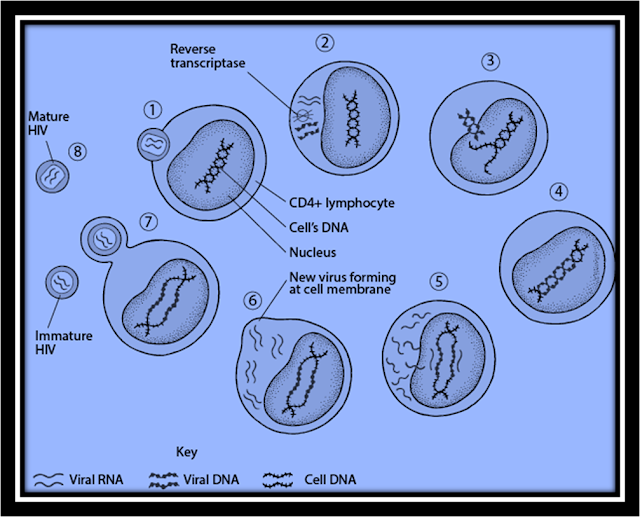HIV and AIDS:
Introduction:
- The human immunodeficiency virus (HIV) is a virus that target host immune cells and turns them into viral factors for HIV reproduction.
- Progression to symptomatic condition of acquired immunodeficiency syndrome (AIDS)
- It has the potential to make the affected individual vulnerable to opportunistic infection that can cause a range of disabilities or death.
- HIV is a relative weak viruses and does not survive well outside the body .Transmission through casual contact and the environment has been unlikely.
Epidemiology:
- By the end of 2007, there are an estimated 33 million people with HIV infection in the world most resident in Southern and Eastern African countries.
Pathophysiology:
- HIV is a retrovirus (that inserts a copy of its RNA genome into the DNA of a host cell that it invades, changing the genome of the cell).
- It is approximately 0.1 microns in diameter, about 1/70th of the diameter of the CD4 cells that it particularly targets.
- HIV is most typically transmitted via blood through sexual contact blood transfusion, intravenous needle sharing, and perinatally (from mother to child)through blood or breast milk.
- As with other infection, there is both and exposure and does requirement for the body to become infected,
- This retrovirus target many cells in the body including gastrointestinal cell, organ cells and immune cells,
- Syndrome is most closely related to the infection of activated CD4 T helper cells which become a viral factory.
- Using its own kits injected substances, HIV RNA is transcribed to DNA particles using reverse transcriptase enzymes.
- DNA is carried to the nucleus integrated into the host DNA using the HIV,s integrase enzyme.
- At this point, the integrated viral material can remain dormant until they are activated, at which time they command the cell to become a viral factory that manufactures viral components.
- Protease enzymes cleave the viral protein for assembly into viral cores.
- Once fully assembled the virus is ready to bud out of the infected host cell.
- As the host CD4 cell manufactures , and releases viruses , it is incapacitated and destroyed.
- In addition, macrophages harboring HIV rendered dysfunctional.
- It is through this process that the immune system is compromised and HIV disease progresses.
Primary HIV infection:
- Is often accompanied by flu - like symptoms and a reduction in CD4 cell counts.
- As CD4 and other cells are damaged and rendered their functional, the body's defenses against infection and malignancy may decline.
- The higher the viral Burden of HIV, the most CD4 cells are infected, rendered dysfunctional and destroyed, leaving the body open to a opportunistic infections and cancers.
- Lower viral load set points are associated with prolonged survival.
- HIV infection is associated with depletion of CD4 cell in the tract, which is where more than 60% of the body's T lymphocytes reside
- This provides a large where of HIV-infected cell in the gut and increased risk for the malabsorption of nutrients.
Oral manifestation and your logic disorders:
- Oral manifestation can be caused by fungal infection viral infection, bacterial condition neoplastic problems, salivary gland diseases and other problems.
- Oral lesions can lead to mouth itching, pain, a burning sensation (especially when eating spicy or acidic food )and taste changes.
- Neurological disorders such as neuropathy and dementia, are common in HIV infection and treatment.
- Neuropathy is often peripheral and associated with pain, numbness ,tingling and burning sensation.
- Pulmonary disorders may occur both related to and unrelated to HIV infection.
- The level of CD4 cell count is related to the risk for the development of several type of pulmonary diseases.
- Some of the main symptoms associated with pulmonary problems, including persistent coughing cause chest pain, fever and shortness of breath may make it more difficult for the patient to maintain adequate food intake.
Cardiac manifestation:
- Cardiac manifestations may include infection and inflammation cardio myopathy and coronary artery diseases.
- Cardiomyopathy may be related to infectious agents, inflammation processes and pharmacologic therapies.
- However, in addition to HIV infection, there are many other factors to consider such as smoking, drinking and other risk factors.
Anemias:
- Anemias are a common occurrence in chronic HIV infection, with higher prevalence in more symptomatic phases of the diseases.
- Anemia can be related to chronic diseases hormonal alterations, infection and medications.
Renal failure:
- Renal failure in the form of HIV associated near four (HIVAN ) is associated with risk factors such as infection, certain medication, male gender and black African ancestry.
AIDS-related wasting syndrome:
- The AIDS related wasting syndrome (AWS) is an AIDS defining diagnosis.
- The definition state that weight loss of 10% without any known cause a campaigned by fever or diarrhea for more than a month is it WAS and qualifies for the diagnosis of AIDS.
- The etiology of wasting may be related to hormonal deficiencies ( testosterone for thyroid) the cytokine dysregulation of an associated with chronic inflammation /infection and metabolic demands of medications.
Best food for HIV patient
- Eat plenty of fruits and vegetables.
- Go for lean proteins. Your body use it to build muscles and a strong immune system. Choose healthy options like lean beef, poultry, fish, egg, bean, nuts.
- Choose whole grains like whole wheat bread. They are boost with B- vitamins and fiber. A plenty of fiber lower your chance of getting fat deposits called lipodystrophy, a potential side effect of HIV.
- Limit your salt and sugar intake: Aim to get less than 10% of calories from added sugar. Limit salt intake to 230mg per day.
- Have healthy fats in moderation.
What is the primary object of nutrition therapy for HIV?
How does HIV/AIDS effect nutrition?
What is best food for HIV patient?
.








No comments
Please do not enter spam link in the comment box